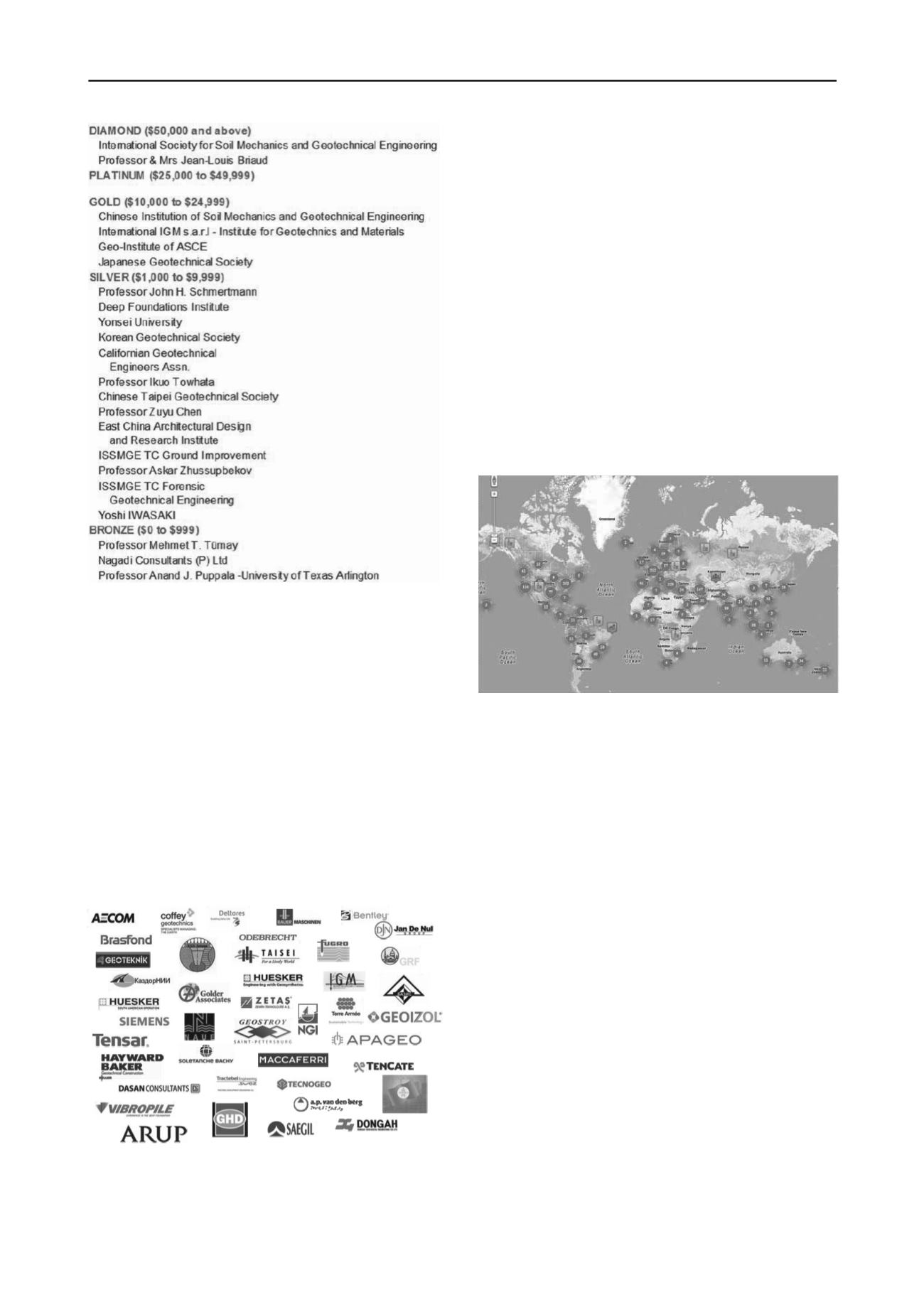
9
ISSMGE - The state of the Society (2009-2013) /
SIMSG - État de la Société (2009-2013)
Proceedings of the 18
th
International Conference on Soil Mechanics and Geotechnical Engineering, Paris 2013
5
Fig. 11 ISSMGE 22 Foundation donors
12 CORPORATE ASSOCIATES
ISSMGE Corporate Associates (Fig. 12) are geotechnical
engineering companies, including consultants, contractors, and
manufacturers who pay dues ($1500/year) to ISSMGE for a list
of benefits (
and
to support the profession. The Corporate Associates
representatives (one per company) also form the Corporate
Associate Presidential Group under the leadership of Michael
Lisyuk of Russia. This group was created to work on aspects of
ISSMGE which could benefit practitioners more specifically. In
2009 we had 21 CAs, today (2013) we have 43 CAs. This
remarkable increase in the number of CAs is due to the hard
work of many people and is very welcome. However this
number still pales compared to the number of CAs in other
international societies closely associated with ISSMGE who
have more than 100 CAs. If you see your company logo on Fig.
12 we really appreciate your support. If you don’t, please
consider joining and supporting your profession.
Fig. 12 ISSMGE 42 Corporate Associates
13 THE INTERNATIONAL JOURNAL OF
GEOENGINEERING CASE HISTORIES
Practitioners often complain that geotechnical journals are too
academically oriented and that there is little useful to them. The
IJGCS fills that gap:
(
geoengineering-case-histories). Born a few years ago in the
mind of Dimitris Zekkos, the IJGCS was endorsed by ISSMGE
in early 2009 and has seen slow but steady growth. It is free of
charge, on line, in color, with embedded spread sheet data when
clicking on the figures. It is particularly welcome by developing
countries which have access to high quality papers for free. It is
not only useful to practitioners but also to professors who can
use the case histories for their students in class. Jonathan Bray
was the first editor in chief followed recently by Pedro Pinto.
The ISSMGE TCs now have the opportunity of setting up
special issues and the ISI rating is around the corner. The future
of the IJGCS is very bright. I urge all of you to consider
publishing a high quality case history in IJGCS. In life you have
your financial wealth potential and your intellectual wealth
potential. Publishing a case history in IJGCS is making an
intellectual gift to developing countries: be generous and take
the time to publish in IJGCS.
Fig. 13 GeoMap within GeoWorld: the new geotechnical engineers
interaction medium
14 GEOWORLD
Again born in the mind of Dimitris Zekkos and endorsed by
IDC and SYMPG, GeoWorld
/) is
to geotechnical engineers what Facebook is to social
networking. It allows geotechnical engineers in the world to
interact and make friends on line, to exchange questions and
answers on various topics, to post examples, and to become
even more connected internationally. Geoworld was launched in
October 2011 and has now reached 2600 individual members,
160 companies, and 76 professional organizations. GeoMap is a
new application within GeoWorld which allows you to find out
members and companies in any geographic area by clicking on
the GeoMap (Fig. 13). You can also find the location of
upcoming conferences worldwide and the location of the case
histories published in the IJGCS.
15 THE NEW ISSMGE WEB SITE
Our new web site was launched in 2012. It was changed to
allow ISSMGE to incorporate the latest technology and to
modernize the look of the pages while maintaining flexibility of
access and modification by the Secretary General’s office. The
new site has a new conferences database, has increased
functionality, hosts the recorded webinars, and promotes the
integration with GeoWorld. The number of visitors has nearly
double in the short time since it has been open going from 2200
visitors in June 2012 to 4000 in March2013 (Fig. 14). It also
now hosts the new electronic version of the Lexicon.


